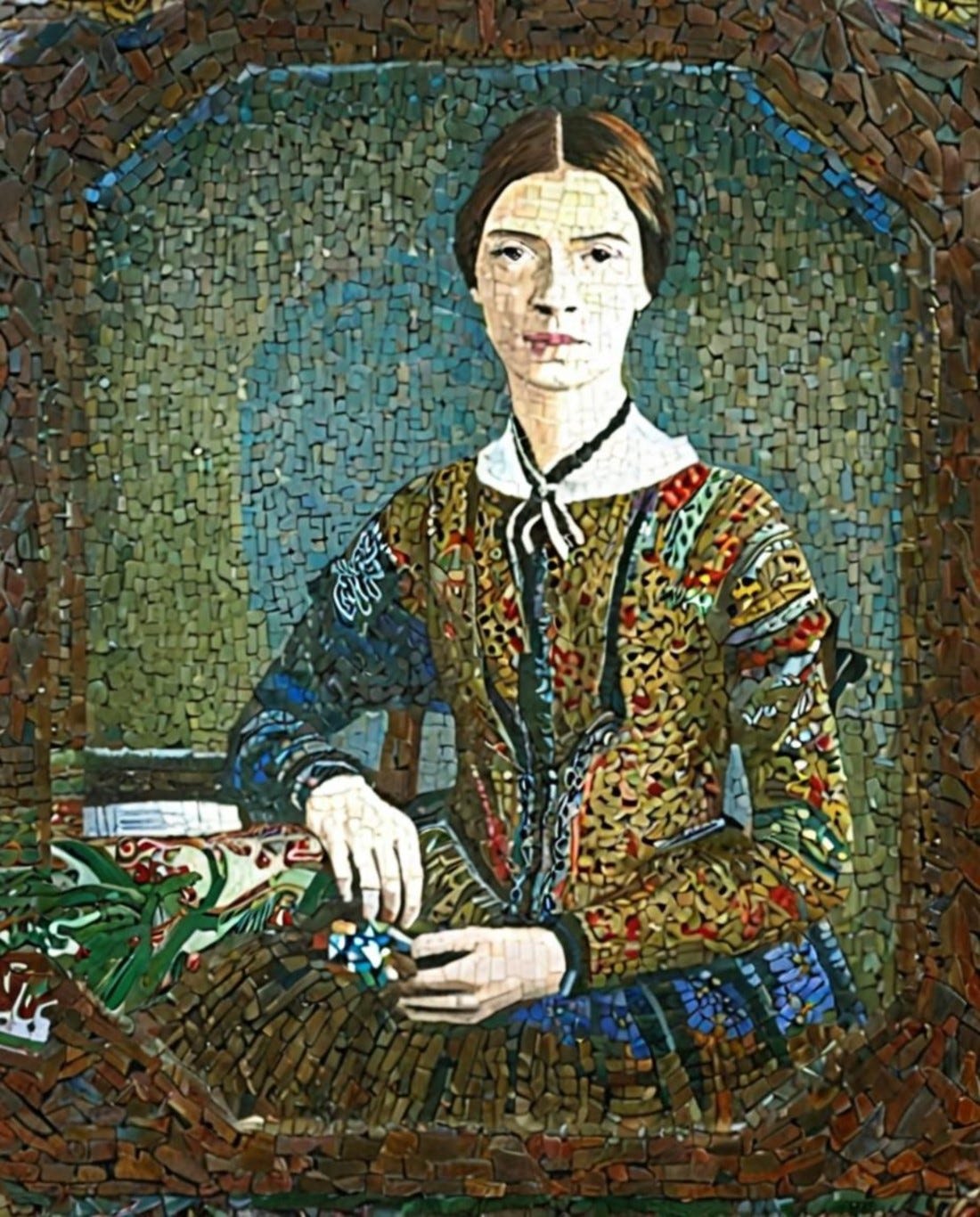I Taste a Liquor Never Brewed
I fed Emily Dickinson's poems to an AI music generator. Here's what happened.
One of my favorite toys as a kid was a spirograph. With plastic shapes and colored pens, my chubby, awkward fingers could draw precise, beautifully layered patterns. In the process I learned something about geometry. Recently, the Suno song generation tool brought back that thrill of borrowed proficiency. I can’t carry a tune to save my life (it’s genetic), and I’ve long forgotten my elementary-school violin lessons. But now there’s this AI thing that will translate my descriptions of tone, mood, and style into songs. I feel like the Wizard of Oz.
As a friend said, “The world is burning and everything is amazing!”
The quality of the computer-generated voices is astonishing, but as with the spirograph, the end result wasn’t really the point; I just wanted to play with a cool toy and learn something new through the intense focus that play brings. AI art and music are creepy only when the aim is product instead of process. Are we gonna leave these powerful tools to the shameless shysters and sinister manipulators, or are we gonna have some fun?
As lyrics, I fed Suno selected Emily Dickinson poems.
I chose Dickinson both because her poems are in the public domain and because they explore a variety of tones, moods, and themes. Schoolbooks typically include her rhyming poems with regular, iambic meter. (As somebody once snarked, “Because I could not stop for Death” can be sung to the tune of “The Yellow Rose of Texas.”) But Dickinson left behind almost two thousand poems with experimental forms, subtle slant rhymes, flowing and halting rhythms, and a vast range of feeling. With my spirograph of song, I wanted to explore and reflect this range.
Dozens of generated songs were comically bad, dully repetitive, or in the case of a heavy-metal version, fixin’ to kill my plants. That’s partly because I’m not proficient with the tool but also because AI frequently gets the inflections wrong. In fact, Suno’s “fails” would be a great way for students to explore the concepts of tone and mood: Why does that line sound wrong? What should it sound like? How is the speaker of the poem feeling, and how does the author want you to feel?
A few versions were exhilarating, though. This song reflected my own mood on a cold, bleak day as afternoon sun slanted toward my desk:
There's a certain Slant of light
Then “Dear March” cheered me up (despite an awkward pause in a line) with a reminder that spring will come:
As I played with Suno, I thought more about Dickinson than ever before. The mystery of her person has been interpreted and reinterpreted through each era’s filters and scopes. Was the “Belle of Amherst” a shy spinster? a tormented artist? a bold feminist? a poetic revolutionary? Did a broken heart trigger her seclusion?
One biographer posits she may have been epileptic. The condition ran in her family, and her schoolmates described what sound like absence seizures in which crockery fell from her hands. At the time, epilepsy was viewed as a shameful, blameworthy affliction; in a woman, it was considered unspeakable. So if she suffered from it, she probably would have hidden herself away, by choice or under pressure from family.
Whatever the reason for her cloistered life, the wonder is that she didn’t go mad and claw at the walls like the narrator of Charlotte Perkins Gilman’s The Yellow Wallpaper. Instead, she wrote thousands of poems and letters that reflect a kaleidoscopic mind and heart in conversation with other people, the natural world, and herself.
The speaker of her poems fears her own inner ghosts:
One need not be a chamber—to be haunted—
Gets joyfully drunk on summer:
I taste a liquor never brewed—
Has a “Bandaged” soul that bursts forth in moments of freedom, only to be recaptured and “Felon led along”:
The Soul has Bandaged moments—
Poignantly, she carries a nameless Grief to which all other griefs call:
I measure every Grief I meet
Emily Dickinson contained multitudes at her small desk more than 150 years ago. She was wren, gypsy, and goblin all in one. At one time or another, some facet of her poetic persona gets “brayed of tongue,” but the whole of her rarely gets sung.
Is it sacrilegious to enlist AI to make different kinds of music from her poems? I think she would’ve been amused to play with it herself.
OK, I didn’t really delete the heavy-metal version of “Because I could not stop for Death.” Here it is. Guard your plants.




This is wild! The opening chords of Dear March reminded me of Indigo Girls, which made me happy. And the heavy metal version...hilarious! It actually kind of works.
“The world is burning and everything is amazing!” is so apt.
AI—OMG.
It was very nice to have a visit with some of Emily Dickinson’s poems and your musings this morning. After some very cold days the sun has come out here and I have Dear March playing. It’s so cheery!